November brings with it a delightful shift in the floral landscape as the cooling temperatures signal a transition in the blooms available for celebration, decoration, and gifting. Flowers that thrive during this time not only provide vibrant colors despite the fading autumn landscape but also carry rich symbolism and charm. This page explores some of the most captivating flowers in bloom throughout November.
Chrysanthemums
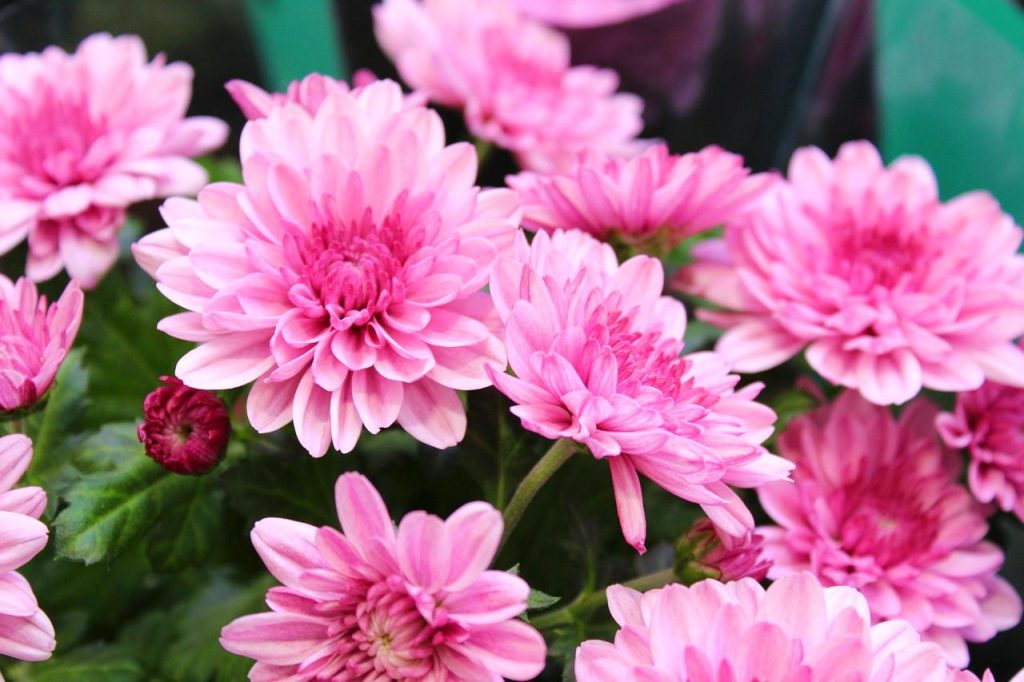
Chrysanthemums, often referred to as “mums,” are perhaps the most iconic November flower. Their rich history stretches back thousands of years, originating in China where they were first cultivated for both aesthetic and medicinal purposes. In many cultures, chrysanthemums symbolize loyalty, longevity, and joy. Their diverse colors, including vibrant reds, yellows, and purples, lend themselves beautifully to various floral arrangements, making them an ideal choice for late-autumn celebrations, including Thanksgiving.
As winter approaches, chrysanthemums tend to thrive in cooler climates, showing resilience in the face of frost. They can be found in many forms, from pom-poms to sprays, and play a significant role in numerous cultural traditions. For instance, in Japan, chrysanthemum festivals are celebrated, showcasing this flower’s importance in society. For gardeners, these hardy perennials can provide a burst of color well into late fall, serving not only as a lovely display but also attracting beneficial pollinators like bees and butterflies before they retreat for the colder months.
To care for chrysanthemums during this period, ensure they are planted in well-draining soil with ample sunlight. Adequate watering and deadheading spent blooms encourage ongoing growth, resulting in a more prolonged display. Incorporating mums into your autumn décor can enhance your seasonal arrangements—placing them in decorative pots or mixing them with other fall florals for a stunning centerpiece.
Asters
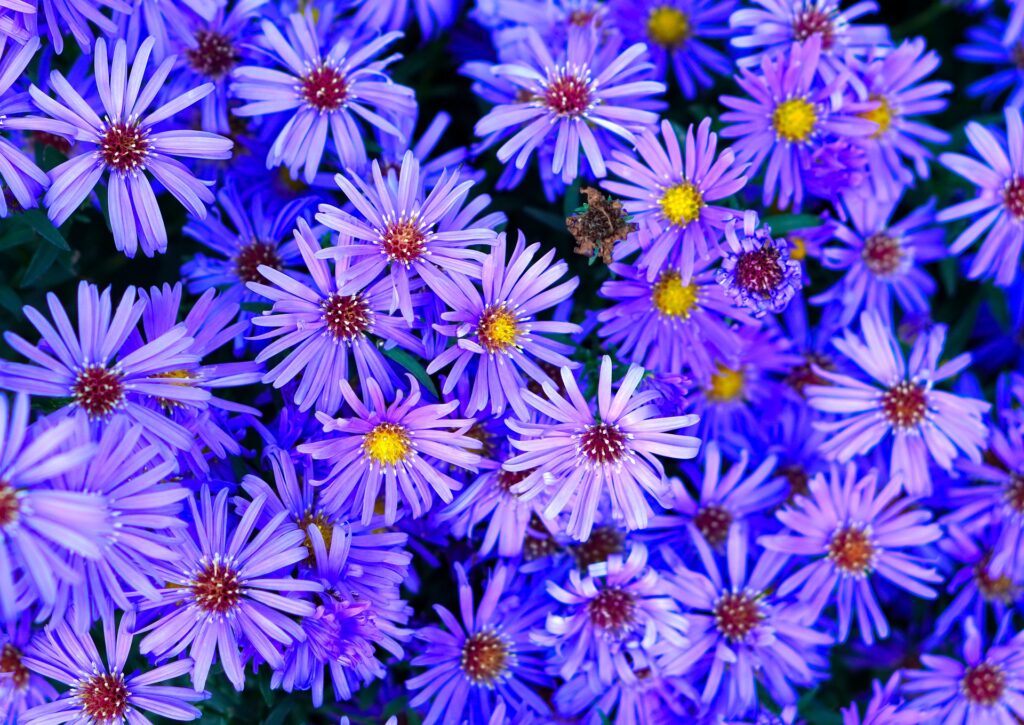
Another floral highlight of November is the aster. Known for their star-like shape, these flowers symbolize love, wisdom, and faith according to various folklore traditions. Asters bloom in a range of colors—from soft pinks and whites to deep purples and blues—creating a stunning visual against the backdrop of a cooling autumn landscape.
Asters are native to North America and are often celebrated for their adaptability and hardiness. Many varieties can withstand early frosts, making them an excellent addition to late-autumn gardens. They not only bring beauty but also serve an ecological role, attracting pollinators such as bees and butterflies that play a crucial role in sustaining local ecosystems. In fact, asters are one of the last blooms to provide nectar and pollen before winter sets in.
For those looking to cultivate aster plants, it’s essential to select a variety that suits the local climate. Some prefer sunny locations while others thrive in partial shade. Regular maintenance, such as watering during dry spells and deadheading, can promote healthy growth and prolong flowering. When arranged with other seasonal elements, asters can add a touch of grace and elegance to flower bouquets as well as autumn wreaths, ensuring your seasonal display stands out.
Camellias
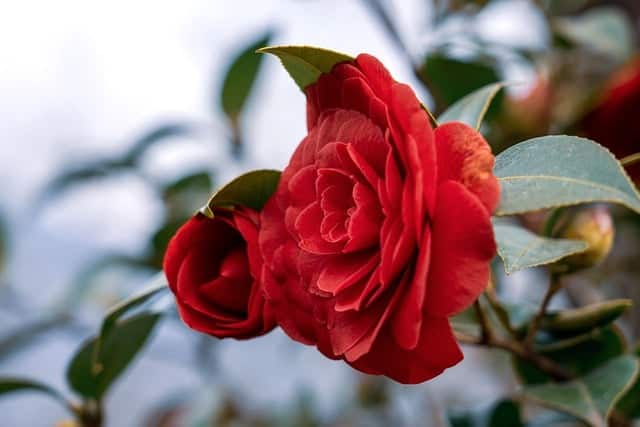
While many might associate November with falling leaves and fading blooms, camellias challenge this notion by producing exquisite flowers during this transitional month. With their lush, waxy petals that come in hues of pink, red, and white, camellias are often regarded as symbols of excellence and admiration. These evergreen shrubs not only add beauty to gardens through their blooms but also provide sturdy foliage that offers year-round interest.
Camellias bloom at varying times depending on the species. Some early-flowering varieties start to emerge in November, bringing freshness and vitality to an otherwise dormant garden. They thrive in mild climates and prefer slightly acidic, well-drained soil, making them a favorite among gardeners in temperate regions. Additionally, camellias are relatively low-maintenance once established; regular watering and an occasional trim can keep them healthy and vibrant.
The cultural significance of camellias is noteworthy. In countries like Japan, they are celebrated during traditional tea ceremonies, representing purity and perfection. Their long-standing association with love and devotion makes camellias a cherished gift during this month, especially with romantic occasions such as anniversaries and engagements.
In floral arrangements, camellias can create an air of sophistication. Their unique floral forms work well in contemporary designs, while their colors seamlessly complement autumn’s earthy tones. Whether used as a statement flower or a supportive element in bouquets, camellias bring a touch of elegance to November floral displays, reminding us that beauty can flourish even as the season begins to change.
Dahlias
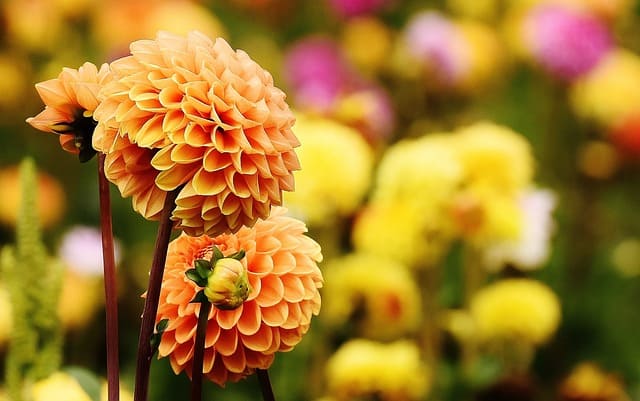
Dahlias are a true showstopper in any November garden. Their vibrant, layered petals come in a stunning variety of shapes and sizes, ranging from the geometric precision of pom-pom types to the free-spirited blooms of dinnerplate dahlias. These flowers represent elegance and inner strength, making them a popular choice in floral arrangements during the fall and winter seasons.
While many dahlias bloom from mid-summer through early fall, certain varieties can continue to showcase their splendor into November with the right care. Ensuring that they are planted in a sunny location and protected from frost can help prolong their blooming period. Dahlias flourish in rich, well-draining soil and benefit from regular watering—especially during dry spells. Mulching around the base can also help retain moisture and moderate soil temperature.
Culturally, dahlias hold significance in various societies. In Mexico, they are revered as the country’s national flower, often used in festivals and celebrations. Their intriguing symmetry and rich hues make them a favored choice for bouquets and arrangements that mark special occasions, from weddings to birthdays. Dahlias can be a striking centerpiece for November gatherings, complementing the warm, rich tones of the season while evoking feelings of gratitude and celebration.
Ranunculus
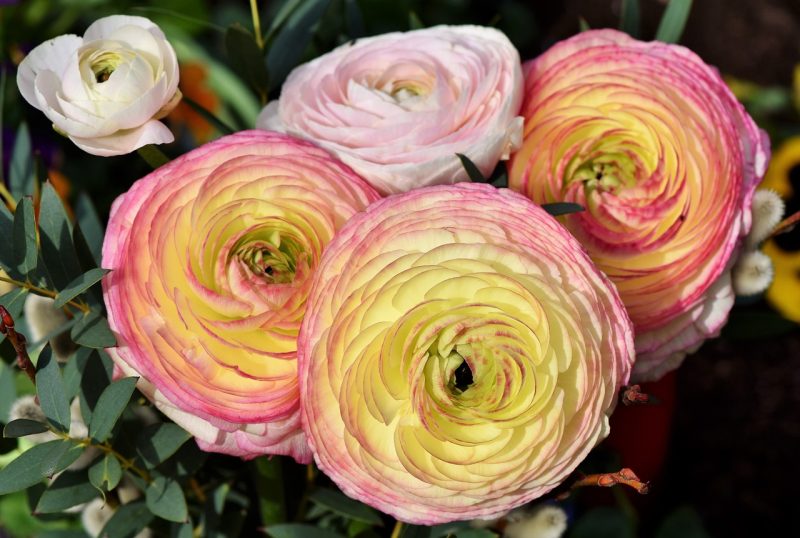
Ranunculus, known for their lush, cup-shaped blooms, are a delight for any floral enthusiast. While they primarily bloom in spring, certain varieties are cultivated to flower in the cooler months, making them an excellent addition to November floral displays. Their delicate petals come in a dazzling array of colors, including soft pastels and vivid primary shades, symbolizing charm, attractiveness, and radiant beauty.
Though ranunculus are often associated with spring, they can be planted as tubers in late summer to bloom in November with proper preparation. They thrive in cool conditions but require well-draining soil and regular watering to prevent any risk of rotting. These charming flowers are also known for their remarkable resilience, allowing them to withstand light frosts, which makes them ideal for late fall gardens.
In addition, ranunculus carry a rich historical significance, often used in art and literature to symbolize fleeting beauty. Their whimsical nature makes them a popular choice for modern floral arrangements, where they can be paired with rustic elements like twigs and dried grasses, creating a striking contrast that captures the essence of late autumn’s transition.
Scabiosa

Scabiosa, commonly known as pincushion flowers, stand out with their unique blooms that resemble soft pincushions filled with delicate pins. Available in shades of purple, blue, white, and pink, scabiosa flowers add a touch of whimsy to any November arrangement. They symbolize love, bliss, and tenderness, making them particularly meaningful during this season of gratitude and reflection.
These hardy flowers are known for their ability to bloom into late fall, providing pops of color and attracting pollinators right up until winter sets in. Scabiosa prefers well-drained soil and a sunny to partially shaded location, and they can thrive in a variety of growing conditions. Regular deadheading will encourage further blooming, making them a low-maintenance yet rewarding addition to November gardens.
Moreover, scabiosa enjoys a long vase life, which adds to its appeal for floral designers. Their interesting textures and formations allow them to blend effortlessly into various floral styles, whether rustic, modern, or traditional. They can add a soft touch to autumn arrangements or create an eye-catching focal point when styled alone. Their ethereal quality resonates well with many floral enthusiasts, making scabiosa an enchanting choice for late autumn bouquets, parties, or seasonal festivities.
Liatris
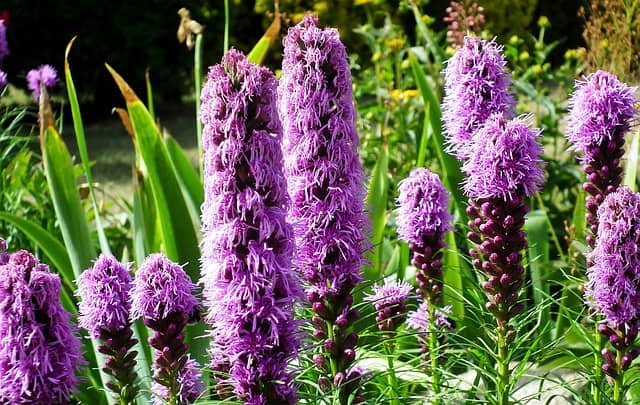
Liatris, commonly known as blazing star or gayfeather, is a striking flower that can bring vertical interest and vibrant color to gardens in November. Its unique spiky flower heads bloom in shades of purple, pink, or white, adding an element of drama with their tall, upright stems that can reach up to four feet in height. Liatris symbolizes pride and sincerity, making it an excellent choice for autumn arrangements that convey heartfelt sentiment.
This perennial is particularly valued for its ability to withstand cooler temperatures and light frosts, allowing it to flourish into late fall. Liatris thrives in well-drained soil and prefers full sun, making it a great candidate for a low-maintenance garden. These hardy plants also attract a variety of pollinators, including butterflies and bees, making them a valuable addition to any ecosystem-conscious garden.
In floral arrangements, liatris provides a long-lasting option that can create striking contrasts with rounder blooms. Their vertical lines add elegance and sophistication, making them ideal for modern designs. When combined with other seasonal flowers like chrysanthemums or asters, liatris can help create arrangements that capture the essence of November while bringing a touch of wild beauty to any bouquet.
Poinsettias
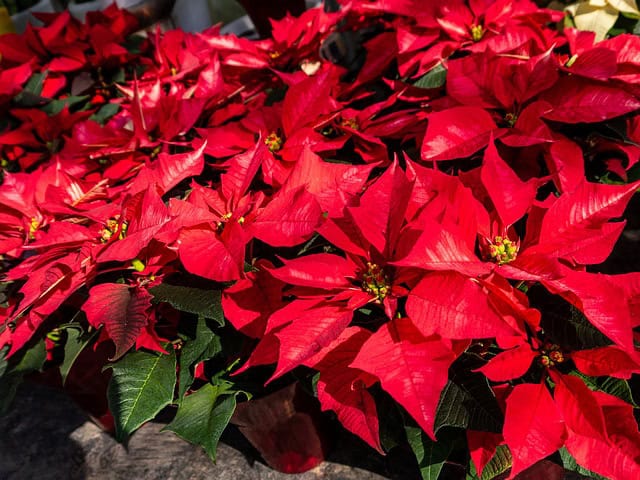
When it comes to November and the holiday season, few flowers evoke as much joy and festivity as the poinsettia. Renowned for their vibrant red and green foliage, these striking plants have become synonymous with Christmas celebrations. Native to Mexico, the poinsettia has deep cultural significance and has been symbolically linked to the holiday season, representing goodwill and success.
Poinsettias are lush, tropical plants characterized by their bracts—modified leaves that surround the tiny, central flowers. While they are most commonly seen in red, they also come in shades of pink, white, and even marbled variations, allowing for a range of décor possibilities. They thrive in bright, indirect sunlight and prefer to be watered only when the soil feels dry to the touch.
To ensure that your poinsettias last throughout the holiday season, it’s essential to avoid placing them near drafts, heat sources, or direct sunlight, as these conditions can cause leaf drop. Their stunning appearance makes them a popular choice for holiday displays and gifts, whether as standalone plants or incorporated into festive arrangements. Using poinsettias alongside other seasonal greenery or flowers can create a vibrant, cheerful atmosphere, embodying the warmth and spirit of the November and December celebrations.
Lisianthus
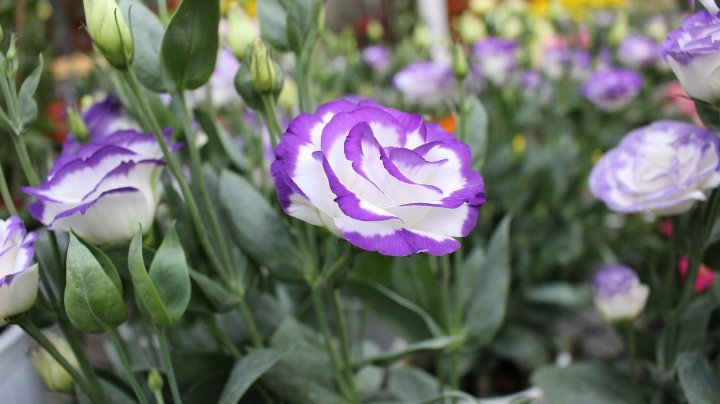
Lisianthus is a flower that elegantly balances grace and durability, making it a favored choice among florists and garden enthusiasts alike, especially as November arrives. With its delicate, rose-like blooms that can be found in a mesmerizing array of colors—from soft pastels to deep, bold hues—lisianthus conveys appreciation and gratitude, making it a wonderful option for gift-giving during this reflective time of year.
Often considered a perennial flower in warmer climates, lisianthus is typically treated as an annual in cooler areas. This flower thrives in well-drained soil, requiring full sun and ample watering to promote healthy growth. It is relatively easy to grow for those willing to invest some care, with its long stems making it ideal for both garden displays and cut flower arrangements.
Lisianthus is particularly popular in bouquets because of its ability to complement other blooms while adding texture and layers. Its gentle fragrance, combined with the variety of colors it offers, allows for wonderful versatility in floral design. As a November flower, lisianthus can add elegance to holiday gatherings, wedding ceremonies, or even simple home décor, embodying the beauty and intimacy of the season.
Celosia

Celosia, often referred to as cockscomb or woolflower, is a spectacular choice for November gardens, with its unique, feathery bloom shapes reminiscent of flame or velvet petals. These heat-loving annuals produce brilliantly colored flowering spikes in shades of red, orange, yellow, and purple, making them standout features in both garden beds and arrangements. Celosia symbolizes affection and adaptability, embodying resilience and beauty even as temperatures drop.
Growing celosia is relatively straightforward, as they thrive in full sun and well-drained soil. While they prefer warm conditions, certain varieties can withstand light frosts, allowing them to add vivid color to late fall gardens. Regular deadheading not only encourages further blooming but also helps keep the plants tidy. These blooms also make fantastic cut flowers, lasting for two weeks or more in arrangements if properly cared for, and they can even dry well, making them ideal for fall wreaths or arrangements.
In floral design, celosia adds a striking and tactile quality, making it a favorite for contemporary arrangements. Their unique shapes can create movement and depth, visually contrasting well with rounder flowers such as dahlias or peonies. Whether used in a rustic autumn bouquet or a vibrant centerpiece for a holiday gathering, celosia truly shines as a November flower.
Snapdragon

Snapdragons are another excellent option for November floral enthusiasts. Known scientifically as Antirrhinum majus, these charming flowers derive their name from the unique shape that resembles a dragon’s mouth, which can be “snapped” open and closed. Their tall, vertical stems are decorated with clusters of vibrant blooms available in nearly every color of the rainbow, from bold reds and yellows to pastel pinks and whites. This flower symbolizes grace, strength, and the hopes for change—perfect sentiments for the reflective nature of late autumn.
Cultivating snapdragons is rewarding, as they are hardy and can thrive in cooler temperatures. These flowers prefer rich, well-draining soil, and they can tolerate light frosts, making them an excellent choice for late fall gardens. For best results, plant them where they receive full sun but are shielded from harsh winds. Regular watering, especially during dry spells, helps maintain their health and longevity.
In floral arrangements, snapdragons offer not just striking beauty, but textural flair, making them ideal for mixed bouquets. Their tall spikes stand elegantly when combined with other seasonal flowers or foliage, and their unique shape adds interest and height to any display. Snapdragons can be used creatively in arrangements ranging from boho to classic styles, embodying versatility that enhances the seasonal aesthetic.
Stock

Stock is a fragrant flower that captivates with its delicate blooms and pleasant aroma, making it particularly appealing during November. With its rich, colorful clusters and whimsical variety of forms—ranging from single to double blooms—stock symbolizes lasting beauty and a bond of affection, fitting perfectly into the warmth of late autumn. Notable for their sweet scent, stock flowers are often used in arrangements to add a fragrant touch that delights the senses.
When planting stock, they flourish in cool weather, making them ideal for November gardens. These cool-season annuals prefer well-draining soil and full sunlight. Given their love for cooler temperatures, they can bloom even in light frost, making them resilient choices for autumn displays. Regular deadheading promotes continued blooming and helps maintain their aesthetic appeal throughout the season.
In floral arrangements, stock brings a soft, romantic touch that pairs beautifully with both vibrant and muted palettes. Their fragrance enhances the overall sensory experience of a bouquet, making them a popular choice for weddings and special occasions. Use stock flowers in the foreground of arrangements, allowing them to intermingle with other blooms like roses or hydrangeas for a lush, full effect. Their delightful scent and charming appearance truly embody the essence of November celebrations.
Pansies

Pansies are among the most beloved flowers of late fall, renowned for their expressive, face-like blooms and vibrant palette. These cheerful flowers, with their wide variety of colors—including rich purples, sunny yellows, and soft whites—persist even in cooler temperatures, making them a staple in November gardens. Pansies symbolize loving thoughts, and their versatility allows them to convey warmth and affection during a time when many seek comfort in the company of flowers.
These hardy annuals thrive in cool seasons, and their velvety petals add texture and charm to containers, borders, and garden beds alike. Pansies prefer well-drained soil and full sun, though they can tolerate partial shade, making them flexible companions in diverse garden settings. Regular deadheading will promote continued blooming and help maintain their vibrant appearance throughout the month.
In floral arrangements, pansies can add a delightful, whimsical touch. Their unique shape and array of colors lend themselves beautifully to a variety of styles, from elegant bouquets to rustic farm-style arrangements. Whether used as stand-alone blooms or paired with other late-season flowers, pansies evoke warmth and joy, brightening the atmosphere as we approach the holidays.
Geraniums

Geraniums are another fantastic choice for November, offering pops of color and elegance to late fall gardens and indoor spaces. Known for their rounded, reaching leaves and clusters of blossoms, geraniums are available in a variety of vibrant hues such as red, pink, white, and blue. These perennial favorites symbolize comfort and friendship, embodying the warmth of gatherings and the joy of shared company during the cooler months.
These adaptable flowers thrive best in well-draining soil and require a considerable amount of sunlight, ideally four to six hours per day. In many regions, geraniums can continue to bloom well into November, especially if protected from frost and harsh winds. They can be grown in garden beds, containers, or hanging baskets, offering flexibility in design and location.
Geraniums are especially favored in indoor floral arrangements, where their captivating blooms can be enjoyed up close. Their long-lasting flowers and pleasant scent make them excellent choices for table centerpieces or delightful gifts. Incorporating geraniums into seasonal arrangements can add richness and depth, making them a valuable addition to any floral design as we transition into winter.
Coronillas
Coronillas, or crown flowers, are a lesser-known gem of November that brings a unique visual appeal and delightful fragrance to gardens as the season shifts. This flowering shrub exhibits delicate, butterfly-shaped blossoms in shades of yellow and cream, often adorned with feathery foliage that adds a soft touch to its overall presence. Symbolizing purity and serenity, coronillas infuse tranquility into any floral arrangement.
These charming blooms thrive best in well-drained soil with plenty of sunlight. While they can tolerate cooler temperatures, they generally prefer a warm environment, so providing protection from harsh frosts is essential for their continued growth. Coronillas are typically dynamic in borders or as part of mixed perennial gardens, creating an exquisite tapestry of seasonal flowers.
In floral design, coronillas bring a unique element that stands out amidst the more traditional November blooms. Their sweet fragrance can enhance bouquets and arrangements, drawing in the attention of both viewers and pollinators alike. Whether arranged with other blooms or featured on their own, coronillas evoke a sense of calm and peace, making them ideal for celebrating the serenity of late fall or early winter.






